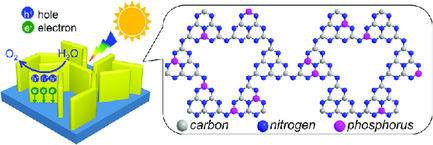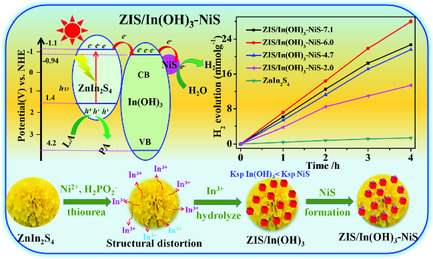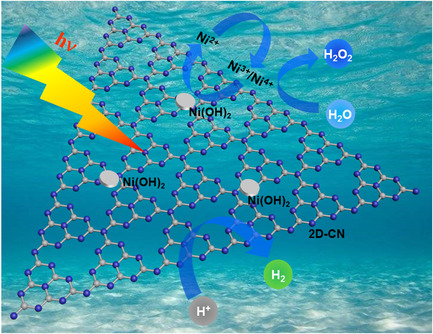Journal list menu
Export Citations
Download PDFs
Cover Picture
Surface/Interface Engineering of Carbon-Based Materials for Constructing Multidimensional Functional Hybrids
- First Published: 11 August 2020

Multidimensional Functional Hybrids
Carbonaceous materials (CMs) such as carbon nanotubes, fullerenes, graphene, carbon quantum dots, graphdiyne, and their derivatives have sparked enormous excitement for solar energy conversion applications. In article number 1900577, Yi-Jun Xu and co-workers focus on the surface/interface engineering issues of diverse CMs. The effects of surface/interface engineering, and the properties and applications of functionalized CMs-based hybrids are highlighted.
Inside Front Cover
Sacrificial Agent-Free Photocatalytic Oxygen Evolution from Water Splitting over Ag3PO4/MXene Hybrids
- First Published: 11 August 2020
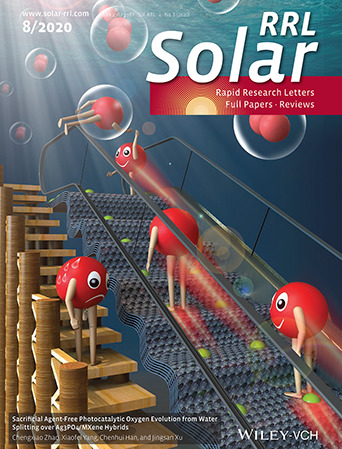
Hybrid Photocatalysts
In article number 1900434, Xiaofei Yang, Jingsan Xu, and co-workers demonstrate a new efficient and stable sacrificial agent–free water oxidation photocatalyst by integrating conductive few-layer 2D Ti3C2 MXene with a well-documented oxygen-evolving material. The constructed Ag3PO4/MXene Schottky heterojunctions exhibit increased light utilization efficiency, accelerated interfacial charge transfer, improved oxygen evolution performance, and highly enhanced photo-stability.
Inside Back Cover
Recent Progress on Exploring Stable Metal–Organic Frameworks for Photocatalytic Solar Fuel Production
- First Published: 11 August 2020
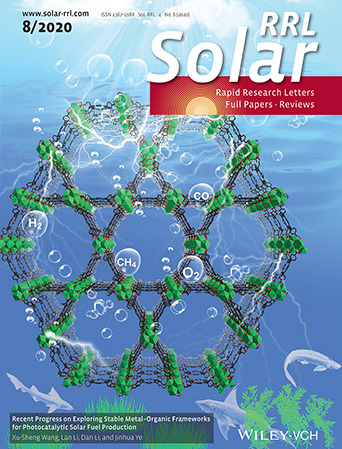
Solar Fuel Production
In article number 1900547, Dan Li, Jinhua Ye, and co-workers summarize the current state-of-the-art progress on metal–organic frameworks (MOFs) for photocatalytic solar fuel production. The strategies for designing stable MOFs and the applications for efficient photocatalytic solar fuel production are comprehensively summarized. The challenges and future perspectives using MOFs for photocatalytic solar fuel production are also discussed.
Back Cover
2D/2D Heterostructured Photocatalysts: An Emerging Platform for Artificial Photosynthesis
- First Published: 11 August 2020
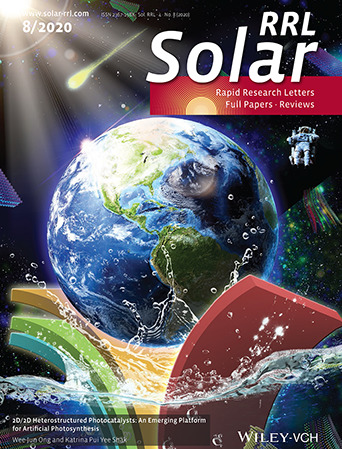
2D/2D Heterostructured Photocatalysts
In article number 2000132, Wee-Jun Ong and Katrina Pui Yee Shak present the latest insights into the interplay of 2D/2D heterojunctions and charge carrier dynamics toward ameliorated photo-driven water splitting, CO2 reduction, and N2 fixation, and discuss challenges and prospects in the field.
Masthead
Editorials
Emerging Nanomaterials for Light-Driven Reactions: Past, Present, and Future
- First Published: 11 August 2020
Progress Reports
2D/2D Heterostructured Photocatalysts: An Emerging Platform for Artificial Photosynthesis
- First Published: 27 May 2020
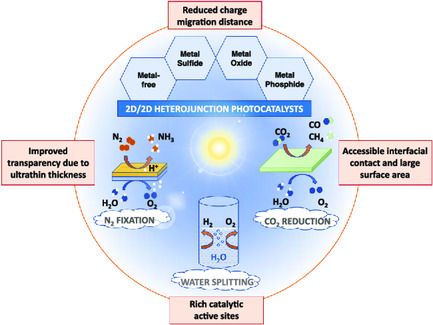
Engineering 2D nanomaterials to form 2D/2D heterointerfaces has received tremendous interest due to the large interfacial contact area for excellent charge migration in photocatalysis. Herein, the latest insights into the interplay of 2D/2D heterojunction and charge carrier dynamics toward ameliorated photo-driven water splitting, CO2 reduction, and N2 fixation are presented. Challenges and prospects in this field are discussed.
Graphitic Carbon Nitride-Based Low-Dimensional Heterostructures for Photocatalytic Applications
- First Published: 19 November 2019
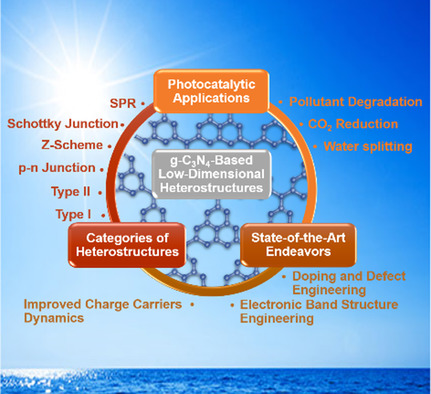
Graphitic carbon nitride (g-C3N4) constructs, state-of-the-art low-dimensional heterostructure photocatalysts modulated via doping and defect engineering, band structures tuning, and charge carrier dynamics to realize enhanced visible light absorption, improved photoinduced charge carrier transport/transfer, and spatially separated electron–hole pairs for improved photocatalytic performances are analyzed. The recent progress in g-C3N4-based low-dimensional heterostructures for water splitting, CO2 reduction, and pollutant degradation is presented.
Reviews
Oxygen Vacancy Engineering in Photocatalysis
- First Published: 07 March 2020
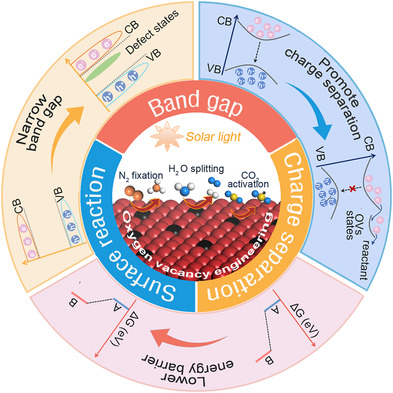
Oxygen vacancy engineering in semiconductive metal oxides is reported to be vital to improve photocatalytic efficiency. This review provides a concise overview of oxygen vacancies in transition metal oxides in photocatalytic systems, including their functions, construction strategies, characterization methods, and applications. Moreover, an outlook on the current challenges and promising opportunities in this research area is provided.
Surface/Interface Engineering of Carbon-Based Materials for Constructing Multidimensional Functional Hybrids
- First Published: 06 March 2020
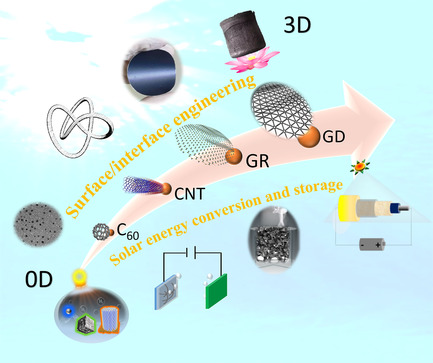
Carbonaceous materials (CMs) are versatile building blocks for constructing multidimensional functional hybrid materials. This Review summarizes the recent progresses in designing efficient CMs-based functional composites for boosted solar energy harvesting through surface/interface atomic, molecular, and defect engineering. The effects of surface/interface engineering as well as the excellent mechanical, electronic, optical properties and applications of the functionalized CMs-based composites are highlighted.
Hydrogen Generation by Solar Water Splitting Using 2D Nanomaterials
- First Published: 07 March 2020
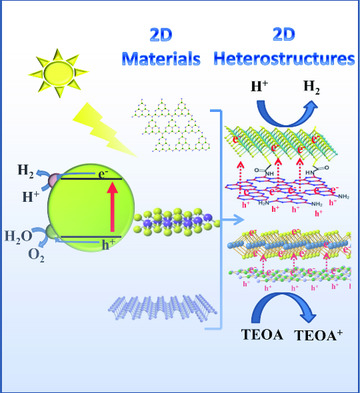
Hydrogen is clearly the most environment-friendly alternative energy source, and its generation by splitting water is the most energy- and environment-friendly approach. A variety of materials are exploited for water splitting of which 2D materials are notable. Herein, a brief review of photocatalytic water splitting carried out using a variety of 2D catalysts is presented.
Recent Progress on Exploring Stable Metal–Organic Frameworks for Photocatalytic Solar Fuel Production
- First Published: 24 January 2020
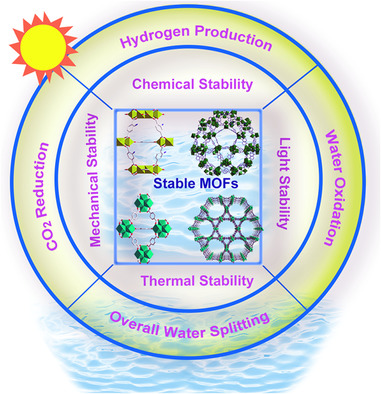
Stable metal–organic frameworks (MOFs) are one of the best choices for a promising platform for photocatalytic solar fuel production due to its adjustable organic ligands and metal nodes, high void architectures, and tunable chemical structures. Possible strategies, such as organic linkers modulation, metal nodes modulation, and morphology and size modulation are summarized to design high-efficiency and stable MOF photocatalysts.
Progress of High-Throughput and Low-Cost Flexible Perovskite Solar Cells
- First Published: 17 January 2020
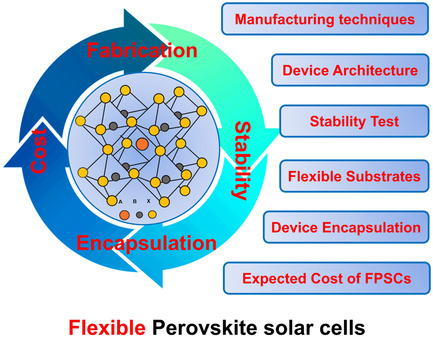
Flexible perovskite solar cells have attracted plenty of attention in both educational and business communities. Herein, the research background is summarized and technological advancement with regard to flexible substrates is evaluated. In addition, different stability tests with and without encapsulation are briefly examined. Last but not least, the upscaling issues and the material costs are also vividly discussed.
Photocatalytic Reduction of CO2 by Metal-Free-Based Materials: Recent Advances and Future Perspective
- First Published: 14 January 2020
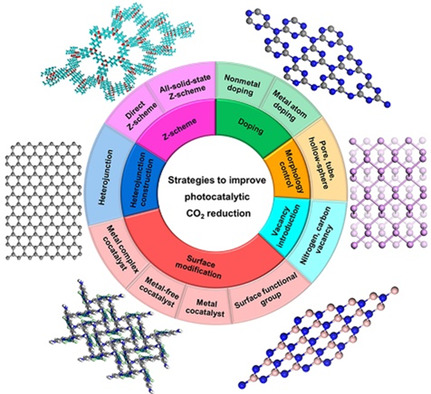
A comprehensive and up-to-date review on metal-free photocatalysis of CO2 reduction is provided, highlighting surface modification of photocatalysts to enhance CO2 absorption and activation. Theoretical calculations and operando techniques are also summarized and discussed to gain insight into possible reduction mechanisms and pathways. Furthermore, future prospects and challenges in photocatalytic CO2 reduction by nonmetallic catalysts are envisioned.
Recent Advances of Metal-Oxide Photoanodes: Engineering of Charge Separation and Transportation toward Efficient Solar Water Splitting
- First Published: 09 January 2020

This Review focuses on the recent progress of metal-oxide photoanodes for photoelectrochemical water splitting. In particular, the engineering of charge separation and transportation of metal-oxide photoanodes, including nanostructuring, crystal facet engineering, doping, junctions, and interfacial modifications, is highlighted. Perspectives on the further development of metal-oxide photoanodes for efficient solar energy conversion are also discussed.
Pure Organic Semiconductor-Based Photoelectrodes for Water Splitting
- First Published: 23 November 2019
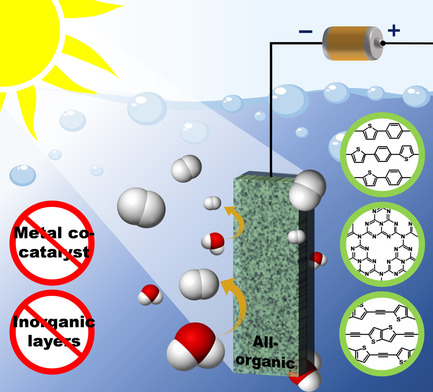
The development and recent advances in the design of all-organic photoelectrodes based on conjugated polymers and small molecules for water splitting are reviewed. The effects of the band energy structure, film morphology, and thickness on the photoelectrochemical properties are discussed. In addition, future directions are briefly presented.
Communications
Insight on the Contribution of Plasmons to Gold-Catalyzed Solar-Driven Selective Oxidation of Glucose under Oxygen
- First Published: 26 March 2020
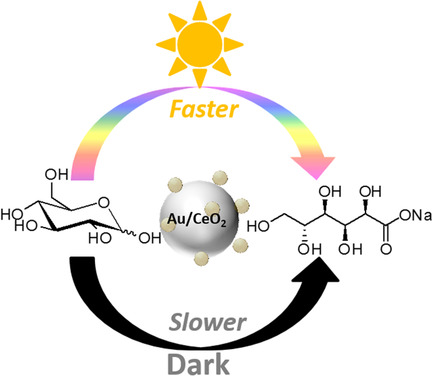
The utilization of solar energy to transform biomass feedstock is an important topic that brings to the forefront the concept of solar biorefineries. Herein, the enhancement of O2-mediated gold-catalyzed oxidation of free sugars using standard illumination conditions is presented. The results highlight that under these conditions, only thermal activation, and not the plasmonic effect, is responsible for the reaction enhancement under illumination.
In Situ Synthesis of Phosphorus-Doped Polymeric Carbon Nitride Sheets for Photoelectrochemical Water Oxidation
- First Published: 21 April 2020
Cerium-Based Metal–Organic Frameworks with UiO Architecture for Visible Light-Induced Aerobic Oxidation of Benzyl Alcohol
- First Published: 29 November 2019
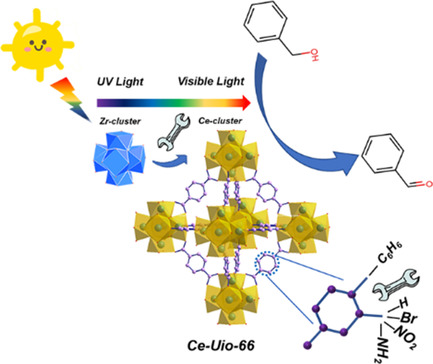
For the first time, the visible light photocatalytic property of Ce-based UiO metal–organic frameworks (MOFs) is studied. Compared with traditional Zr-UiO MOFs, not only the light absorption range extends, but also the carrier separation accelerates. Significantly, a ligand-dependent charge separation efficiency is observed and unveiled via electrochemical tests and photoluminescence spectroscopy, and the possible reaction mechanism is further proposed.
Efficient Bio-Photoelectrochemical Reaction at a TiO2 Nanowire Array-Based Triphase Interface
- First Published: 05 June 2019
Full Papers
Mechanistic Study of Monolayer NiP2 (100) toward Solar Hydrogen Production
- First Published: 14 September 2019
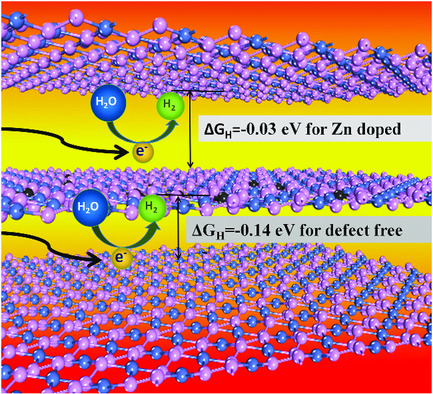
The catalytic mechanism and thermodynamic stability of monolayer NiP2 (100) are explored as cathode material for solar water splitting. Based on comprehensive theoretical study, surface P atoms with only one single PP bond possess excellent hydrogen evolution reaction (HER) activity. Zn-doping can further enhance the HER activity. Accordingly, the synthesis of these materials for experimental verification is proposed.
Intentional Extrinsic Doping into ZnFe2O4 Nanorod Photoanode for Enhanced Photoelectrochemical Water Splitting
- First Published: 16 October 2019

Intentional extrinsic doping of Ti4+ or Sn4+ into Fe3+ sites of the zinc ferrite (ZnFe2O4) nanorod photoanode as an electron donor enhances photoelectrochemical water oxidation activity mainly by improving the bulk charge carrier density. When annealed at high temperatures, it also improves the surface charge separation by forming a surface oxide layer of the dopant that passivates surface defect sites.
Metallic MoO2-Modified Graphitic Carbon Nitride Boosting Photocatalytic CO2 Reduction via Schottky Junction
- First Published: 19 October 2019
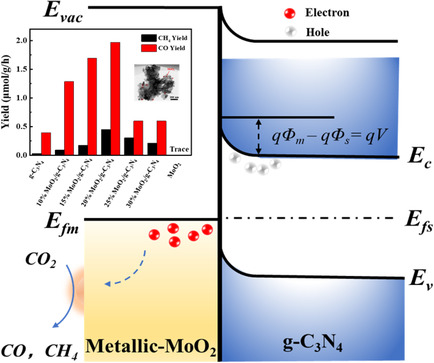
Metallic MoO2-modified g-C3N4 via an ultrasound-assisted method achieves high efficiency photocatalytic CO2 reduction. Due to the Schottky junction between metallic MoO2 and g-C3N4, charge transfer and separation greatly accelerate. The simultaneous evolution of CH4 and CO in metallic MoO2/g-C3N4 is 15 and 5 times greater, respectively, than that in a g-C3N4 photocatalyst, realizing an ideal strategy for CO2 reduction.
Sacrificial Agent-Free Photocatalytic Oxygen Evolution from Water Splitting over Ag3PO4/MXene Hybrids
- First Published: 29 October 2019
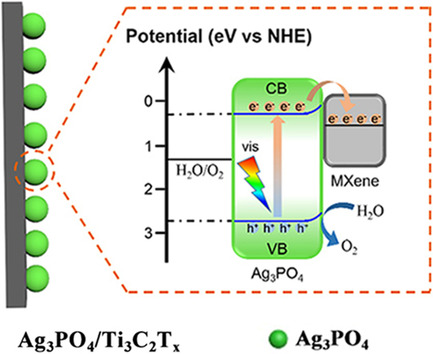
A Ag3PO4/MXene hybrid is constructed via in situ deposition of Ag3PO4 particles on exfoliated MXene nanosheets. The composite shows an enhanced photocatalytic O2-evolution performance even in the absence of a sacrificial electron acceptor. The improvement of O2 generation is credited to the electron “pool” effect of 2D MXene and the hydrophilic functionalities on the surface of MXene.
In Situ Fabrication of Robust Cocatalyst-Free CdS/g-C3N4 2D–2D Step-Scheme Heterojunctions for Highly Active H2 Evolution
- First Published: 06 November 2019
Investigation on the Influence of Sc Ions Doping on the Structure and Performance of Ta3N5 Photocatalyst for Water Oxidation under Visible Light Irradiation
- First Published: 16 November 2019
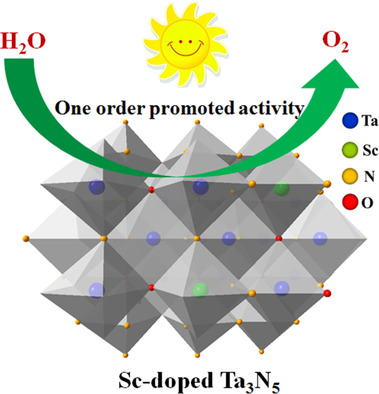
Herein, doping of foreign Sc ions into the lattice sites of Ta3N5 is systematically investigated, which is found to be effective to inhibit the formation of reduced tantalum species, and thereby improve charge separation as well as the O2 evolution rate of Ta3N5 from water under visible light irradiation by one order together with loading of CoOx cocatalyst.
Nanocages of Polymeric Carbon Nitride from Low-Temperature Supramolecular Preorganization for Photocatalytic CO2 Reduction
- First Published: 22 November 2019
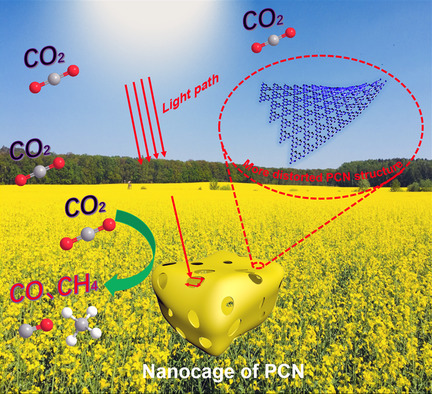
Nanocages of polymeric carbon nitride (CN) are rationally synthesized via a low-temperature supramolecular preorganization approach with subsequent calcination. The nanocage structure of polymeric CN facilitates light harvesting, charge transfer, and CO2 adsorption due to the higher specific surface area, and the extended π-delocalization, conjugated aromatic system with more exposed lone-pair electrons, thus improving the performance of photocatalytic CO2 reduction.
Synthesis of Copolymerized Carbon Nitride Nanosheets from Urea and 2-Aminobenzonitrile for Enhanced Visible Light CO2 Reduction with a Ruthenium(II) Complex Catalyst
- First Published: 12 December 2019
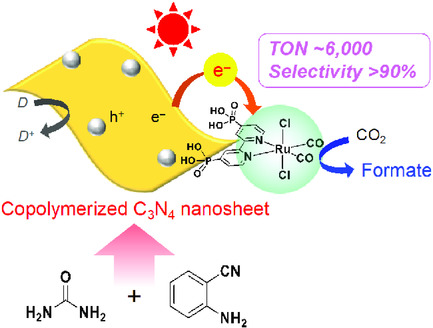
Copolymerized carbon nitride nanosheets, synthesized from urea and 2-aminobenzonitrile, are capable of reducing CO2 into formate with high selectivity (>90%) under visible light (λ > 400 nm) when combined with a ruthenium(II) complex catalyst. The reinforced visible light absorption of the copolymerized material contributes to an enhanced photocatalytic activity, as compared with the urea-derived pristine carbon nitride.
Ternary g-C3N4/ZnNCN@ZIF-8 Hybrid Photocatalysts with Robust Interfacial Interactions and Enhanced CO2 Reduction Performance
- First Published: 13 December 2019
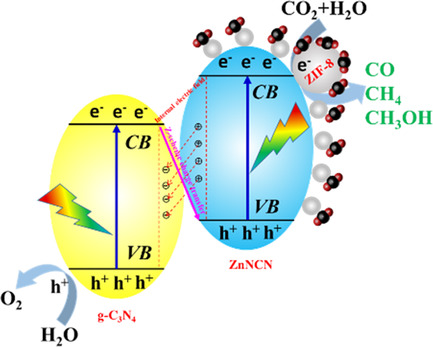
Ternary g-C3N4/ZnNCN@ZIF-8 hybrid photocatalysts with robust interfacial interactions via ZnN bonding are constructed by sequential in situ interfacial reactions, to overcome the two shortcomings of g-C3N4 photocatalyst regarding poor charge separation ability and limited CO2 adsorption ability, and to enhance photocatalytic CO2 conversion efficiency, due to the synergetic effects of g-C3N4/ZnNCN interfacial Z-scheme heterostructuring and surface-passivated ZIF-8 grafting.
A Novel Synthesis Yielding Macroporous CaFe2O4 Sponges for Solar Energy Conversion
- First Published: 05 February 2020
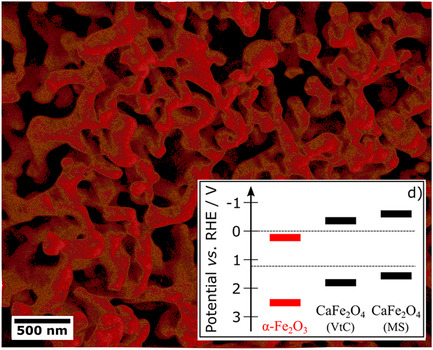
Macroporous sponge-like structures of highly crystalline CaFe2O4 are synthesized via microwave reaction and subsequent thermal annealing. The optical and electronic properties of the material are thoroughly characterized, and the ability to generate photocurrents under illumination with visible light is demonstrated.
Bismuthiol-Mediated Synthesis of Ordered Carbon Nitride Nanosheets with Enhanced Photocatalytic Performance
- First Published: 05 February 2020

Photoactive carbon nitrides are obtained by thermal condensation of supramolecular assemblies composed of bismuthiol and melamine with different solvents. The modified carbon nitrides show enhanced optical absorption, increased specific surface area, and improved charge separation efficiency, which promotes the hydrogen production rate, nearly 16 times more than that of the bulk counterpart.
In situ Observation of Electrodeposited Bimetallic p-Si Micropillar Array Photocathode for Solar-Driven Hydrogen Evolution
- First Published: 12 March 2020

In situ-generated Ni+2 active species offers a new perspective regarding the catalytic behavior of electrodeposited Ni–M (Mo, Co, Fe) alloys onto the micropillar array p-Si photocathode for solar-driven hydrogen evolution reactions. The adaptive species onto the surface of NiMo through the light-induced activation in alkaline solution enhances the photoelectrochemical properties with regard to NiCo and NiFe.
Hierarchical Architectured Ternary Nanostructures Photocatalysts with In(OH)3 Nanocube on ZnIn2S4/NiS Nanosheets for Photocatalytic Hydrogen Evolution
- First Published: 20 March 2020
Accelerating the Hole Mobility of Graphitic Carbon Nitride for Photocatalytic Hydrogen Evolution via 2D/2D Heterojunction Structural Advantages and Ni(OH)2 Characteristic
- First Published: 05 February 2020
g-C3N4/TiO2 Composite Film in the Fabrication of a Photocatalytic Air-Purifying Pavements
- First Published: 13 May 2020
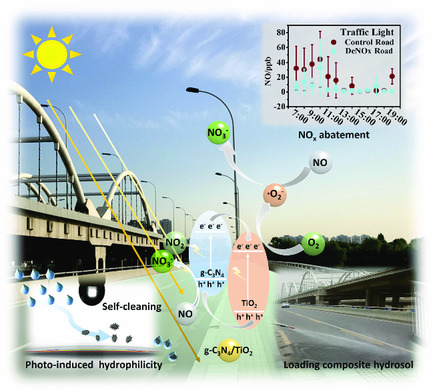
Photocatalytic air-purifying pavement is fabricated by spraying a graphitic carbon nitride/titania composite hydrosol on the road at room temperature. The composite coating is firmly attached to the substrate, exhibiting nitrogen oxide removal activity and ideal self-cleaning performance. The removal efficiency is influenced by solar irradiation and traffic volume. The latter has more significant influence than former.





